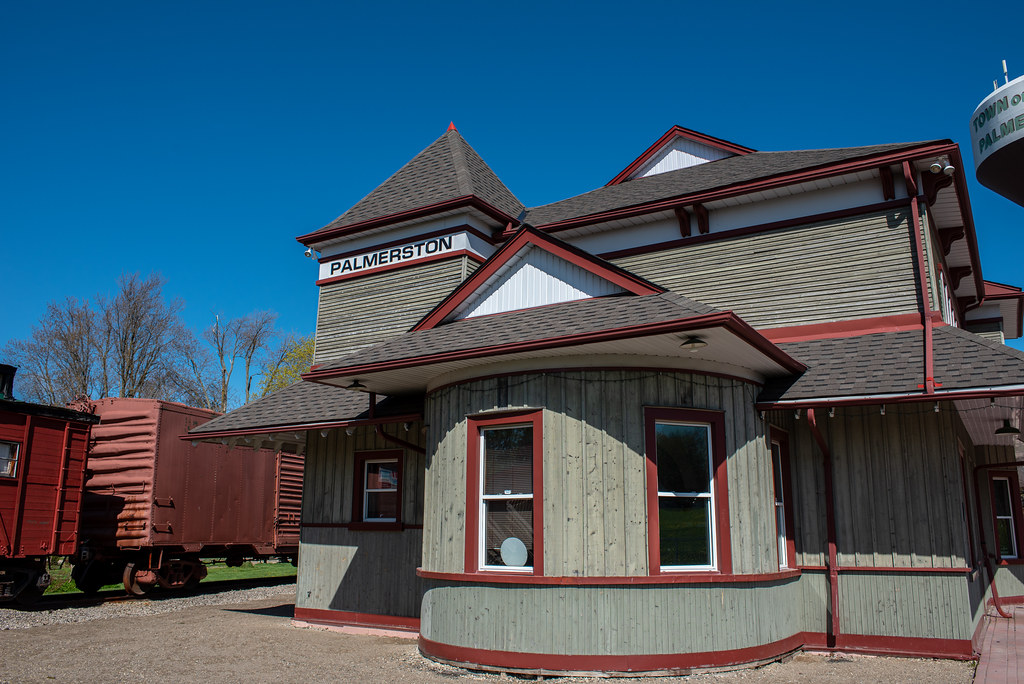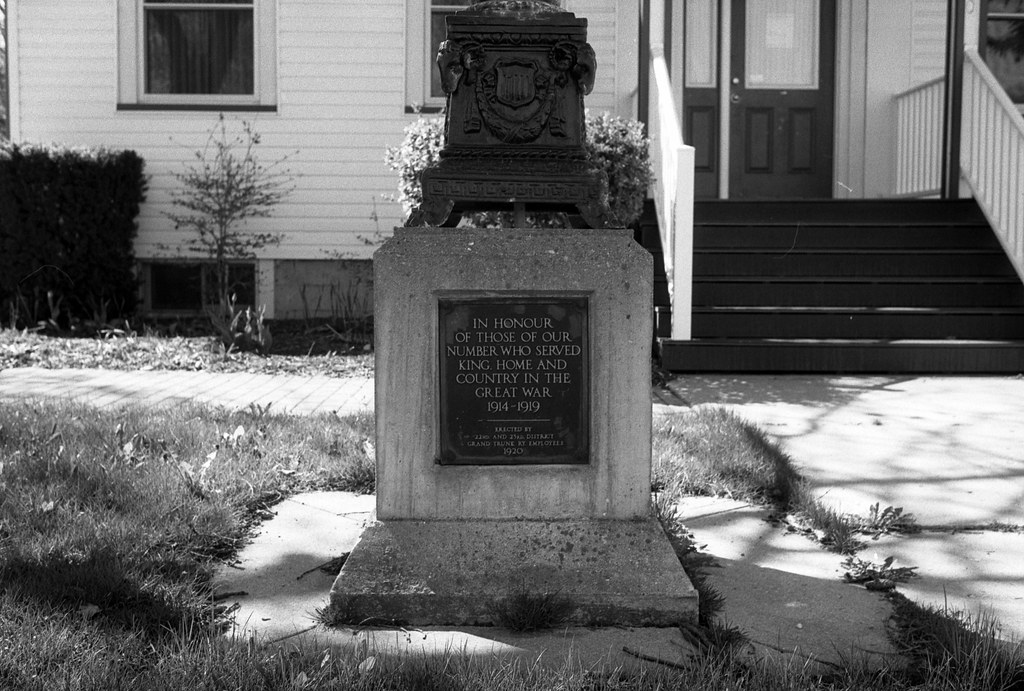If you haven’t heard of Palmerston, Ontario, that is perfectly understandable. It is a small historic town tucked away in the rural areas of Wellington County. But the town owes its existence in a major form thanks to the railroad and is one of a few communities that can claim that. At the railroad’s height, Palmerston was a major centre for Grand Trunk and later Canadian National during the golden age of rail and also found a place in history as the location of one of Canada’s first vaccine farms because of the railroad.

Graflex Crown Graphic – Nikon Nikkor-W 1:5.6/180 – Ilford HP5+ @ ASA-200 – Pyrocat-HD (1+1+100) 9:00 @ 20C
The Wellington, Grey & Bruce Railway starts during the waning days of the first railroad boom in the pre-confederation years. The original charter stated that the mainline would run from Toronto to Southampton with options for branch lines to Owen Sound and Guelph. While originally chartered in the colonial era, it would lapse in 1861 before being picked up by a new group of investors in 1864. The new investors decided on a shorter run starting in Guelph, terminating in Southampton, and accessing Toronto through a traffic sharing agreement with Great Western. Construction would start in 1867, with Great Western taking over the incomplete network in 1869. Right away, Great Western would decide to build a branch line from Harriston to Kincardine with a route running through the small farming settlement. The branch line would start construction in 1871 and settle in 1874. The sudden arrival resulted in the quick growth of the community, thanks mainly to the donation of land by the area’s two prominent landowners. The name Palmerston was chosen and, in 1875, incorporated as a town. A station had been completed in 1871, a simple board-and-batten one-storey building. The station featured a single general waiting room, station master’s office, and baggage room as a branch line. There was also a ticket window and telegrapher bay. The mainline from Guelph to Southampton saw completion in 1872 and the branch to Kincardine in 1873. The same year, Great Western purchased a majority share in the company. The geographical placement of Palmerston proved that the town was to become a major railway hub. By 1876, the station had a second floor added, the first-floor waiting for the area, telegrapher bay, and ticket window expanded. At the same time, the station master’s office and other administrative functions of the new yard moved to the second floor. A roundhouse, coal and freight sheds and a turntable were added. Palmerston proved a major junction in the Great Western network but always remained a financial burden. When Grand Trunk Railways purchased Great Western in 1882, they gained the Wellington, Grey & Bruce network at the same time. And while the operation of Wellington, Grey & Bruce proved a financial burden, the importance of Palmerston was truly realized by Grand Trunk, who had extensive western holdings and found itself a key division point with sixty-five divisions. Grand Trunk would drop the Wellington, Grey & Bruce name in 1896.

Nikon D750 – AF-S Nikkor 28-70mm 1:2.8D
Nikon D750 – AF-S Nikkor 28-70mm 1:2.8D
The dawn of the twentieth century saw a great deal of work done at Palmerston. Grand Trunk would repaint the station in its own colours of grey, green, and mauve and build a tower to provide better traffic direction for the yard. The tower would burn down in 1912, but the station itself was saved. To prevent injury and death, Grand Trunk completed a pedestrian bridge over the massive rail yards. The reason being that the fastest route for students to get from their homes to school was through the rail yards. In 1895 the first Vaccine farm in Ontario opened in Palmerston; the rural setting and the divisional crossroads allowed smallpox vaccines to reach every point in Ontario and some even in the US quickly to help control the deadly virus. Even when Canadian National absorbed Grand Trunk in 1923, Palmerston remained an important junction in their massive network. The large station proved expensive to heat, and drop ceilings were installed in 1936 to save money during the great depression. The 1950s brought further changes with the station getting a new railroad red paint job. The end of steam motive power in 1960 saw many of the support buildings at Palmerston demolished, the coal sheds and roundhouse were demolished, and the turntable removed. Canadian National would donate the last steam locomotive to operate at Palmerston, Old 81, a 2-6-0 Mogul locomotive for display downtown. All that remained were kilometres of tracks, the pedestrian bridge and the station. The final passenger train to roll through Palmerston was in 1970. Canadian National began abandoning unused or duplicated lines in 1982; the old Kincardine branch was among those, and the last parts of the tracks were torn up by 1996.

Nikon D750 – AF-S Nikkor 28-70mm 1:2.8D
Nikon FM – AI-S Nikkor 35mm 1:2.8 – Fomapan 100 @ ASA-100 – Rollei Supergrain (1+15) 7:30 @ 20C
Canadian National maintained ownership of the old station but left it closed and abandoned in all but name. Rather than attempt to sway Canadian National, the community rallied around the old station central to the town’s development. Roof repairs were needed by 1998, and the community raised the required funds to complete the job. And in a twist, Canadian National offered the station to the community and the sale was completed that same year. But it was not only the station but the entire railyard. Palmerston’s historical society and the municipal government began the long process of rumination. The station itself was restored to early 20th century colours and some tracks and out-buildings preserved. Most of the land became green space, known as CNR Park, with one entrance still flanked by the preserved Old 81 locomotive. The pedestrian bridge also underwent repairs and remains open to the public, with the station becoming home to a railway museum that seeks to preserve and tell the area’s history related to the railroad. The Palmerston Railway Heritage Museum is the only surviving Wellington, Grey & Bruce Railway station in Ontario. Many were demolished during the abandonment of the branch line in 1982, although some sections have been turned into walking trails. The museum boasts some examples of rolling stock, and of course, Engine 81 remains on display. The park offers up much needed green space, and the pedestrian bridge offers one of the best views of the entire park and surviving tracks. It’s not hard to imagine the space once crammed with cars and locomotives at the height of railroad usage.
An orphan, my grandfather was a British Home Boy who was transplanted to the Palmerston area in the mid 1880s.
Eventually, he worked at GTR.